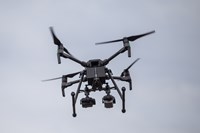Equipment
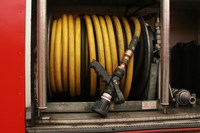
Hose reels
These are connected to the fire engine and are the black or yellow hoses you see stored on reels. They are used for smaller fires or fires that do not require large volumes of water.
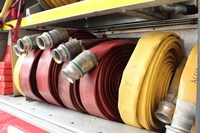
Hose jets
These hoses are more powerful than the hose reels and pass larger quantities of water. They need two firefighters to operate them as they are so powerful - one stands in front and controls the nozzle and the other stands behind and supports the front firefighter. When firefighters arrive at a fire and need to use these hoses, they first run them out and then attach them to the back of the fire engine to connect them to the pump and water supply. Afterwards, when they are finished, firefighters run them over their shoulders to clear any remaining water inside them, and roll them up again.
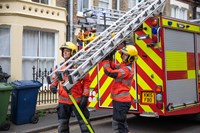
Ladders
There are four ladders stored on a standard fire engine of different heights that are used for different purposes. The 13.5 metre ladder is the longest of the four ladders. For safety, this requires four firefighters to carry and place it. There is also a nine metre ladder, a short extension ladder similar to a household ladder, and a roof ladder. There is also a step ladder on the fire engine which firefighters use to fit smoke alarms in people's homes.
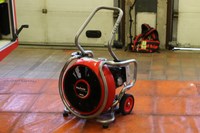
Positive pressure ventilation fan
Positive pressure ventilation fans can be used in two different ways. They can be used to defensively fight a fire, and can be turned on to assist in clearing smoke from a property following a fire.
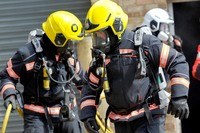
Breathing apparatus (BA) sets
There are four BA sets on board the fire engine and firefighters wear them when they are dealing with incidents where there is smoke or chemical fumes. They wear the cylinders of air on their backs like a rucksack and these are connected by a tube to a face mask which fits over the face and is secured by straps around the head. The sets have a gauge which is on the shoulder strap in the front and firefighters check this regularly to see how much air they have left in the cylinder. They can last around 30 to 35 minutes on average on one cylinder of air. After an incident the cylinders are re-filled using a compressor.
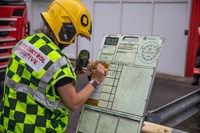
BA entry board
Each firefighter who enters a building or confined space wearing a breathing apparatus (BA) set is recorded onto the BA board. The identification tag from their BA set, which contains their name, is slotted into the board and the time they went in is written next to it. One firefighter has the role of entry control officer and is in charge of this board, signing people in and out. If a firefighter wearing a BA set gets in to trouble, or is running out of air in their cylinder, the identification tag sounds an alarm to alert the entry control officer and immediate action can be taken.
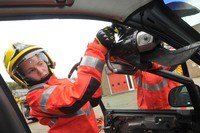
Cutters
These are used primarily for cutting people out of vehicles following a road traffic collision (RTC). They are extremely powerful with a cutting force of 95 tonnes, and can cut through metal like scissors cut through paper.
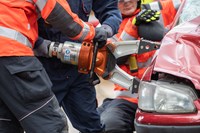
Spreaders
These are primarily used for releasing people trapped in their vehicle after a road traffic collision. Their powerful jaws spread to approximately 70cm. An example of their use is forcing open a car door if it cannot be opened after a crash.
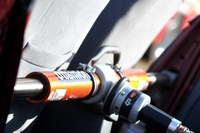
Rams
There are different sized Rams carried on our fire engines. They are used to create space and assist with vehicle stabilisation while firefighters are cutting up vehicles and rescuing casualties.
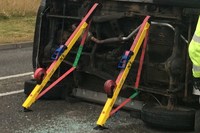
Stabfast stabiliser
Stabfast is a device used by crews to assist with stabilising a vehicle when dealing with a road traffic collision.
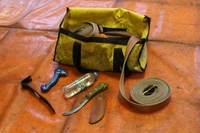
RTC kit
In addition to the cutters and spreaders, there are a number of other small tools on-board the fire engine to help firefighters deal with rescuing people from vehicles. These include a windscreen glass protector, sharp object covers to protect both casualty and firefighters of hazards underneath, pedal cutters (to cut car pedals), and a knife to cut seatbelt straps.
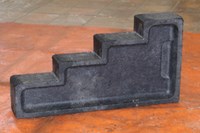
Step blocks
These are wedged around parts of a car to prevent it from moving while firefighters are using the rescue equipment.
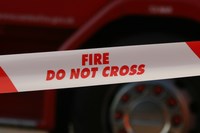
Do Not Cross tape
This red and white striped tape is used to cordon off an area during an incident to protect the public and control access to the area.
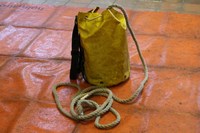
Line bag
A 'line' is a length of rope and firefighters use different types: there is a general purpose line (15m and 30m) for hauling or lowering equipment and a guide line for when firefighters enter a smoke-logged building - they trail the rope as they go and they can then find their way out again by following the line back.
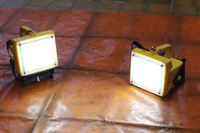
Lighting
On top of the fire engines are large powerful lights which can illuminate a scene in the dark. There are also transportable lights in the lockers that can be rigged up away from the fire engine.
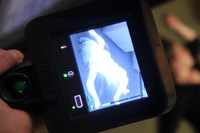
Thermal imaging camera
This handheld device has a special camera which reads temperatures. There is a screen on the other side which the operator can see which shows hot areas by red patches. Firefighters use this mainly to look for hotspots in buildings to see if a fire has spread, or to locate a fire if it is not obvious from the outside of the building. They can also be used to find casualties in the dark as warm body temperatures contrast on the screen to the cold surroundings.
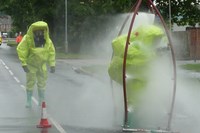
Gas tight suit
Gas tight suits are worn over a firefighter's usual protective clothing and BA set to prevent them from being contaminated by any dangerous substance, be it a solid, liquid or a gas. After the incident they are hosed down or stand in a portable shower to wash any dangerous particles away.
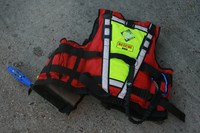
Personal floatation devices (PFD's)
Personal floatation devices are worn by firefighters if they are working near, in or on water.
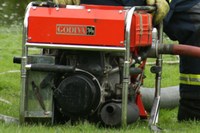
Light portable pump (LPP)
Although there is a large and powerful pump within the fire engine, the Light Portable Pump is a smaller transportable one which can be moved to water supplies when the fire engine cannot get there. A special hose with a filter on the end connects from a water supply to the pump and a standard hose jet is then connected from the pump. It can also be used to pump water, for example flood water, away from an area in the same way. For this a special suction hose is used. If larger quantities of water are required, or water needs pumping in greater volumes, the High Volume Pump is used.
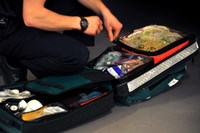
First aid kit
All firefighters are first aid trained and carry a large first aid kit on the fire engine. If fire crews arrive before ambulance crews and paramedics, they can provide emergency first aid to people who are injured.
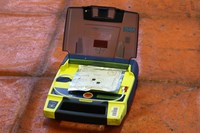
Defibrillator
This is a medical piece of equipment carried in the first aid kit, which sends an electric shock to restart a person's heart. If fire crews arrive at a scene before ambulance crews and paramedics, and a person suffers a cardiac arrest (their heart stops beating), firefighters are trained to use the defibrillator to help them.
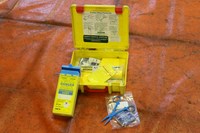
Needle and syringe pick-up kit
This allows firefighters to safely pick up and dispose of needles and syringes.
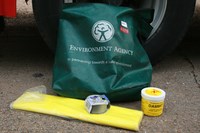
Environmental grab bag
This contains putty to stop a leak, absorbent to soak up liquid and mats to put over drains to stop harmful substances from getting into the water supply. They are mainly used during chemical spill incidents.
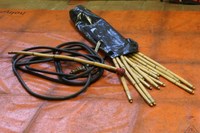
Chimney rods and hose
These special rods and hoses are used for dealing with chimney fires.
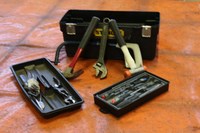
Toolbox
The toolbox contains all the equipment you would expect to find in a standard tool kit including a hammer, screwdrivers, spanners, a saw, pliers and a chisel.
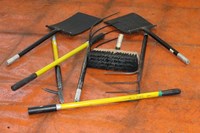
Jafco tools
All fire engines carry a set of Jafco tools including pitch fork, broom, spade, beaters etc. These are often used at the scenes of incidents to assist with clearing access and clearing debris.
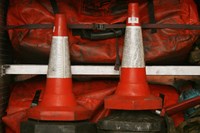
Traffic cones
If firefighters arrive at a scene before police, they can cone the area off to protect themselves (especially if on a road) and to cordon off the area.
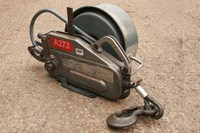
Tirfor
A Tirfor is a winch that can be used at a multitude of incidents. Newer fire engines also have a vehicle-mounted winch.
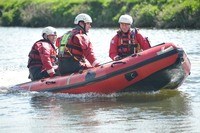
Boats
The inflatable boats are used for on-water rescues. The boat and engine are stored separately on the rescue vehicle and quickly fixed together at the scene of an incident
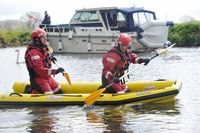
Rescue sled
Rescue sleds are carried on our rescue pumps. They can be used at a variety of rescues to assist with retrieving a casualty from a water-rescue situation. They do not have a motor and are different to the rescue boat.
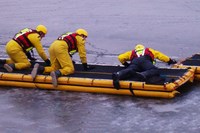
Ice path
The ice path is an inflatable horizontal platform which can be used to rescue people trapped on ice, in water or in mud.
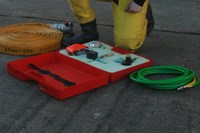
Inflatable rescue hose
The inflatable rescue hose is filled with air and stretched across a river to act as a barrier, stopping any object or person from continuing along the water.
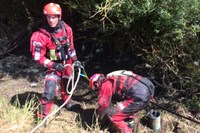
Dry suits
Dry suits help keep firefighters warm and dry when in the water and protect their bodies from cuts and scrapes. They wear their life jacket over the top and also wear a helmet to protect their heads.
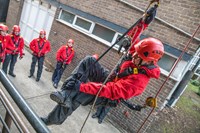
Working at height equipment
Firefighters at Huntingdon fire station are specially trained in rescues from height. This assists when rescuing casualties and tackling a fire from a height. The kit includes harnesses and ropes.
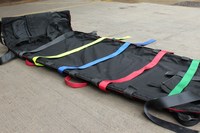
MIBS stretcher
Multi-integrated Bodysplint Stretcher (MIBS) is used for rescuing injured people from confined spaces. They can be strapped onto the flexible stretcher and winched up.
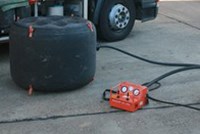
Airbags
There are two types or airbag used for lifting - high pressure and low pressure. The low pressure airbag (pictured) is larger but the high pressure air bag can lift a greater weight.
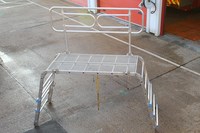
HGV platform
HGV platforms are portable pieces of kit stored flat on rescue and light rescue pumps. They adjust in height and assist firefighters when trying to access and rescue casualties from heavy goods vehicles. They are also used in other rescue and access situations.
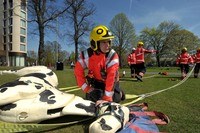
Animal rescue kit
Some firefighters are specially trained to rescue a variety of animals from differing situations. Specialist kit and equipment is carried on fire engines, including strops, rope lines, spreader bars, lifting slings and halters. A plastic horse, known as Roscoe, is also a CFRS training aid to help firefighters train.
